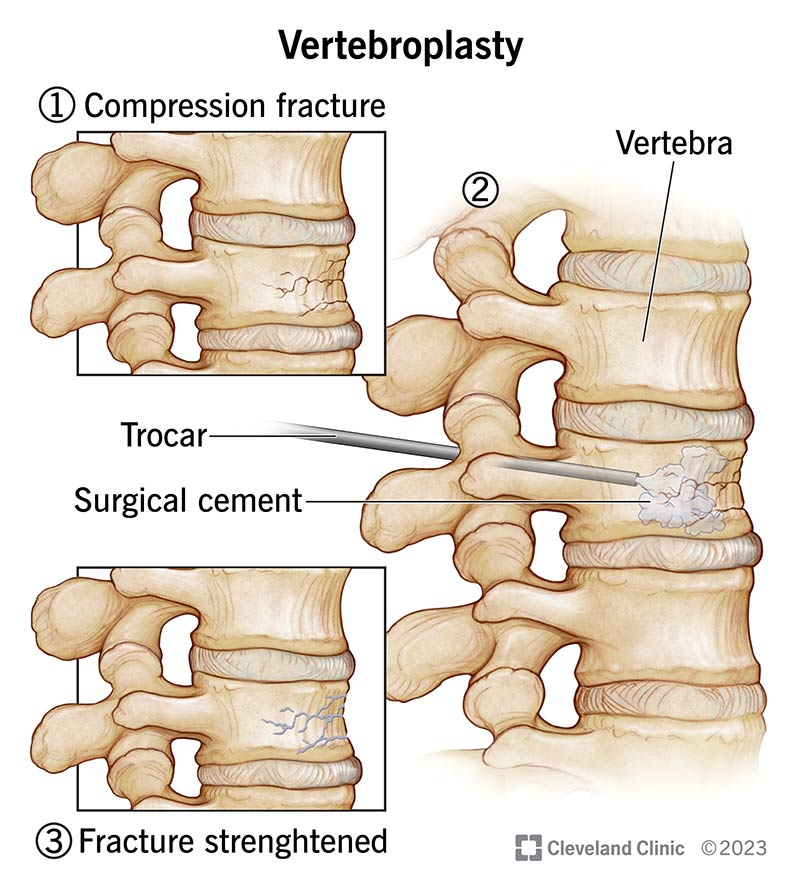Vertebroplasty is a procedure to treat compression fractures in your spine. It helps relieve pain, often caused by osteoporosis or a spinal tumor. It’s minimally invasive and you can go home the same day as the procedure. You may feel relief as soon as 48 hours after you leave the hospital or outpatient clinic.

Vertebroplasty is a minimally invasive outpatient procedure to treat spinal compression fractures. Compression fractures are breaks in the bones that make up your spine (vertebrae). When the broken pieces of bone rub together, it causes pain. Vertebroplasty uses surgical cement to hold your bones in place to prevent them from collapsing and provide pain relief.
You may hear a healthcare provider refer to vertebroplasty as a percutaneous vertebroplasty.
Vertebroplasty treats compression fractures. These bone breaks happen due to:
You may be a candidate for vertebroplasty if you have severe pain caused by a compression fracture. This pain lasts for at least two months and doesn’t get better with other forms of treatment like rest, medications and physical therapy.
No. A vertebroplasty isn’t a major surgery. It’s minimally invasive and you’ll go home the same day as your procedure.
Over 6,000 vertebroplasty procedures happen each year in the United States.
Advertisement
Cleveland Clinic is a non-profit academic medical center. Advertising on our site helps support our mission. We do not endorse non-Cleveland Clinic products or services. Policy
If your healthcare provider recommends vertebroplasty, you’ll meet with a surgeon. They’ll perform a physical exam to review your symptoms and the results of several tests, which may include:
During this visit, you’ll schedule the procedure. Your surgeon will give you specific instructions to follow before vertebroplasty that may include:
On the day of your procedure, you’ll go to a hospital or outpatient clinic at your scheduled time. You’ll change into a gown and lay on your stomach in the treatment room. An anesthesiologist will give you moderate sedation or general anesthesia while your surgeon will perform the procedure. You won’t feel strong, sharp pain during vertebroplasty.
After the anesthetic sets in, your surgeon will insert a needle into your skin. They’ll use a type of X-ray called fluoroscopy to guide the needle into the proper position in your bone. Through the needle, your surgeon will inject surgical cement into the affected area of the bone. The cement holds your bones together.
A vertebroplasty procedure takes about one hour per treated bone.
Advertisement
When your surgeon finishes the procedure, they’ll remove the needle and place a bandage over the puncture site. You’ll need to leave this bandage on for a couple of days as your healthcare provider recommends. You may need someone’s help to remove the bandage from your back when it’s time to take it off.
Someone will have to drive you home after your procedure. You can go home the same day and should anticipate resting for about 24 hours. Avoid any heavy lifting or strenuous exercises for a few weeks following vertebroplasty.
The benefits of vertebroplasty include:
An estimated 87% of people who undergo vertebroplasty reported pain relief following the procedure.
Advertisement
A healthcare provider will discuss the possible side effects of vertebroplasty before your procedure. Complications are rare but may include:
The recovery time for vertebroplasty is short. You may want to rest for 24 hours following the procedure before returning to your regular routine. Avoid strenuous activities for six weeks following vertebroplasty.
You may notice pain relief and better mobility within 48 hours. Some people report they felt immediate pain relief after vertebroplasty. You might feel sore from the procedure, but that goes away within three days. Ice can help relieve soreness at the puncture site.
Both vertebroplasty and kyphoplasty are procedures to treat compression fractures in your spine. During kyphoplasty, a surgeon will use a needle to inflate a small balloon which opens up space for the cement to fill in the fracture. The balloon isn’t part of vertebroplasty, but a surgeon will inject the same cement to repair the fracture during this procedure. Kyphoplasty is more common than vertebroplasty.
A note from Cleveland Clinic
Vertebroplasty is a safe procedure to treat compression fractures. It has a good success rate in relieving pain. You might feel pain relief immediately, or it could take a few days before you feel better. While side effects are possible, the risk is low. If you have any questions about the procedure, talk to your surgeon or healthcare provider. They’re available to answer any questions you have before and after treatment.
Last reviewed on 11/30/2023.
Learn more about the Health Library and our editorial process.
Advertisement
Cleveland Clinic is a non-profit academic medical center. Advertising on our site helps support our mission. We do not endorse non-Cleveland Clinic products or services. Policy